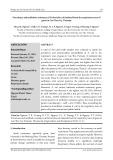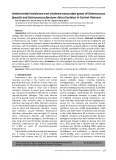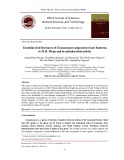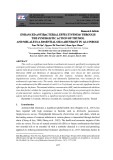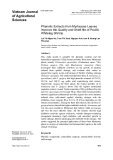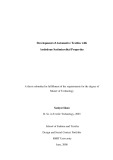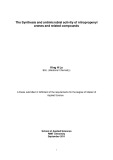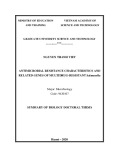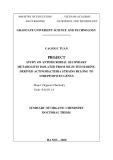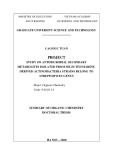doi:10.1111/j.1432-1033.2004.04332.x
Eur. J. Biochem. 271, 3943–3952 (2004) (cid:1) FEBS 2004
Subproteomics analysis of Ca2+-binding proteins demonstrates decreased calsequestrin expression in dystrophic mouse skeletal muscle
Philip Doran1, Paul Dowling1, James Lohan1, Karen McDonnell1, Stephan Poetsch2 and Kay Ohlendieck1 1Department of Biology, National University of Ireland, Maynooth, County Kildare, Ireland; 2GE Healthcare Bio-Science, Freiburg, Germany
analysis showed that the expression of key Ca2+-binding proteins of the luminal sarcoplasmic reticulum is drastically reduced. This included the main terminal cisternae constituent, calsequestrin, and the previously implicated Ca2+-shuttle element, sarcalumenin. In contrast, the (cid:1)Stains- All(cid:2)-positive protein spot, representing the cytosolic Ca2+- binding component, calmodulin, was not changed in dystrophin-deficient fibres. The reduced 2D (cid:1)Stains-All(cid:2) pattern of luminal Ca2+-binding proteins in mdx prepara- tions supports the calcium hypothesis of muscular dystro- phy. The previously described impaired Ca2+ buffering capacity of the dystrophic sarcoplasmic reticulum is prob- ably caused by a reduction in luminal Ca2+-binding proteins, including calsequestrin.
Keywords: calsequestrin; mdx; mouse skeletal muscle; mus- cular dystrophy; sarcalumenin.
Duchenne muscular dystrophy represents one of the most common hereditary diseases. Abnormal ion handling is believed to render dystrophin-deficient muscle fibres more susceptible to necrosis. Although a reduced Ca2+ buffering capacity has been shown to exist in the dystrophic sarco- plasmic reticulum, surprisingly no changes in the abundance of the main luminal Ca2+ reservoir protein calsequestrin have been observed in microsomal preparations. To address this unexpected finding and eliminate potential technical artefacts of subcellular fractionation protocols, we employed a comparative subproteomics approach with total mouse skeletal muscle extracts. Immunoblotting, mass spectro- metry and labelling of the entire muscle protein complement with the cationic carbocyanine dye (cid:1)Stains-All(cid:2) was per- formed in order to evaluate the fate of major Ca2+-binding proteins in dystrophin-deficient skeletal muscle fibres. In contrast to a relatively comparable expression pattern of the main protein population in normal vs. dystrophic fibres, our
therapies is hindered by a lack of the efficient introduction of sufficient amounts of dystrophin-positive muscle precur- sor cells into bulk tissue. Biological approaches, such as the up-regulation of utrophin [16] or inhibition of myostatin [8], may not result in long-term improvement because of difficulties with the regeneration of dystrophin-deficient fibres [5]. This array of biomedical problems suggests that it would be worthwhile studying alternative approaches.
factors,
Duchenne muscular dystrophy is a lethal genetic disease of childhood that affects approximately 1 in 3500 live males at birth, making it the most frequent neuromuscular disorder in humans [1]. Since the pioneering discovery of the DMD gene encoding the membrane cytoskeletal protein, dystro- phin [2], and the biochemical identification of a dystrophin- associated surface glycoprotein complex [3], a variety of promising therapeutic strategies have been suggested to counteract the muscle-wasting symptoms associated with X-linked muscular dystrophy [4]. This includes pharmaco- logical intervention [5–8], myoblast transfer [9] and stem cell therapy [10,11], as well as gene therapy [12–15]. However, to date no therapeutic approach has been developed that provides a long-lasting abolishment of progressive muscle wasting in humans. Gene therapy is associated with serious immunological deficiencies, and the success of cell-based
To overcome the potential problems associated with drug-, cell- or gene-based therapy approaches, and in order to unravel new pathophysiological the application of high-throughput analyses, such as microar- ray technology or proteomics screening, might unearth new targets in the treatment of muscular dystrophy [17]. Expression profiling to define the molecular steps involved in X-linked muscular dystrophy by Tkatchenko et al. [18] and Chen et al. [19] suggests that, besides other destructive mechanisms, abnormal ion handling triggers an altered developmental programming in degenerating and regener- ating fibres. This agrees with the calcium hypothesis of muscular dystrophy [20–22]. Deficiency in the Dp427 isoform of dystrophin results in the reduction of a specific subset of sarcolemmal glycoproteins [23,24]. The lack of the surface membrane-stabilizing dystrophin–glycoprotein complex causes the loss of a proper trans-sarcolemmal linkage between the actin membrane cytoskeleton and the
Correspondence to K. Ohlendieck, Department of Biology, National University of Ireland, Maynooth, Co. Kildare, Ireland. Fax: +353 1 708 3845, Tel.: +353 1 708 3842, E-mail: kay.ohlendieck@may.ie Abbreviations: ECL, enhanced chemiluminescence; IPG, immobilized pH gradient. (Received 4 June 2004, revised 6 August 2004, accepted 12 August 2004)
3944 P. Doran et al. (Eur. J. Biochem. 271)
(cid:1) FEBS 2004
extracellular matrix component laminin [25]. This, in turn, renders the sarcolemma more susceptible to microruptur- ing [26]. Probably, the introduction of Ca2+ leak channels during the natural process of surface membrane resealing triggers increased cytosolic Ca2+ levels in dystrophin- deficient muscle fibres [27]. Increased cytosolic Ca2+ levels contribute to enhanced protease activity, resulting in muscle degeneration [28].
Company (Poole, Dorset, UK), with the exception of acetonitrile (Amersham Biosciences) and the a-cyano-4- hydroxycinnamic acid matrix kit (Laserbiolabs, Sophia- Antipolis, France). Protease inhibitors were purchased from Roche Diagnostics GmbH (Mannheim, Germany). Chemiluminescence substrates were obtained from Perbio Science UK (Tattenhall, Cheshire, UK). Primary antibod- ies were from Affinity Bioreagents (Golden, CO, USA; mAb VIIID12 to calsequestrin, mAb XIIC4 to sarcalu- menin, mAb IIH11 to the fast SERCA1 isoform of the sarcoplasmic reticulum Ca2+ ATPase, mAb IIID5 to the a1-subunit of the dihydropyridine receptor, and pAb to calreticulin), (Novocastra Laboratories Ltd., Newcastle upon Tyne, UK; mAb DYS-2 to the C-terminus of the dystrophin isoform Dp427), Sigma Chemical Company (mAb 6D4 to calmodulin) and Upstate Biotechnology (Lake Placid, NY, USA; mAb C464.6 to the a1-subunit of the Na+/K+ ATPase and mAb VIA41 to a-dystroglycan). Peroxidase-conjugated secondary antibodies were obtained (Temecula, CA, USA). from Chemicon International Protran nitrocellulose membranes were from Schleicher and Schuell (Dassel, Germany). All other chemicals used were of analytical grade and purchased from Sigma Chemical Company.
Preparation of total muscle extracts
In addition to disturbed cytosolic Ca2+ levels, the Ca2+ buffering capacity of the dystrophic sarcoplasmic reticulum is also significantly impaired [29]. The pathophysiological consequence of a reduced Ca2+-binding capacity of the sarcoplasmic reticulum is an amplification of the elevated free cytosolic Ca2+ levels in muscular dystrophy, thereby accelerating the Ca2+-dependent proteolysis of muscle proteins [20–22]. Recent studies suggest that this is partially caused by a reduction in the minor Ca2+-binding protein, sarcalumenin [30], and possibly because of an altered oligomerization status of the major luminal Ca2+ reservoir element, calsequestrin [31]. Surprisingly, immunoblotting of calsequestrin revealed no changes in the abundance of the 63 kDa molecular mass monomer in normal vs. dystrophic microsomes [29]. As subcellular fractionation protocols may distort comparative immunoblotting data, it was of interest to re-examine the fate of calsequestrin by studying the entire complement of key Ca2+-binding elements in dystrophin- deficient skeletal muscle fibres. Because the carbocyanide dye (cid:1)Stains-All(cid:2) represents an established biochemical tool to reproducibly visualize Ca2+-binding proteins following electrophoretic separation [32], we combined the 2D gel technique, dye binding and mass spectrometry to identify (cid:1)Stains-All(cid:2)-labelled muscle proteins and thereby determine, reliably, changes in their expression levels in muscular dystrophy. This approach identified 11 major dye-positive elements in normal fibres and a reduction in eight of these protein species in mdx fibres, including the 63 kDa molecular mass spot representing the calsequestrin mono- mer. Thus, in addition to our previous observation that minor Ca2+-binding elements, such as sarcalumenin [30], and the calsequestrin-like proteins CLP-150, CLP-170 and CLP-220 [29], are affected in dystrophin-deficient fibres, this study demonstrates that the main luminal Ca2+-binding protein, calsequestrin, is also greatly reduced in mdx skeletal muscles. Hence, impaired Ca2+ buffering of the dystrophic sarcoplasmic reticulum appears to be caused by the abnormal expression of the main luminal Ca2+-binding protein species.
Experimental procedures
Materials
For the comparative gel electrophoretic analysis of normal vs. dystrophic skeletal muscle fibres, total extracts of the muscle protein complement were prepared from 9-week-old normal control C57BL/10 mice and age-matched mdx mice of the Dmdmdx strain (Jackson Laboratory, Bar Harbor, ME, USA). One gram of fresh tissue was quick-frozen in liquid nitrogen and ground into fine powder using a pestle and mortar. Subsequently the muscle tissue powder was resuspended in 5 mL of ice-cold buffer A [0.175 M Tris/ HCl, pH 8.8, 5% (w/v) SDS, 15% (v/v) glycerol, 0.3 M dithiothreitol]. To avoid protein degradation, the solution was supplemented with a freshly prepared protease inhibitor cocktail (0.2 mM pefabloc, 1.4 lM pepstatin, 0.15 lM apro- tinin, 0.3 lM E-64, 1 lM leupetin, 0.5 mM soybean trypsin inhibitor and 1 mM EDTA) [33]. In order to eliminate excessive viscosity of the extract as a result of DNA, 2 lL of DNase I (200 units) was added per 100 lL of buffer [30]. Following filtration through two layers of miracloth and the addition of four volumes of ice-cold 100% (v/v) acetone, the tissue homogenate was mixed by vortexing and then incubated for 1 h at )20 (cid:2)C to precipitate the total protein fraction. The suspension was centrifuged at 5000 g for 15 min. The resulting protein pellet was washed in 20 mL of ice-cold 80% (v/v) acetone and thoroughly broken up by vortexing and sonication. The centrifugation and washing step was repeated once and the final protein precipitate collected by centrifugation and resuspended in 1 mL of buffer B [9.5 M urea, 4% (w/v) CHAPS, 0.5% (w/v) ampholytes, pH 3–10, and 100 mM dithiothreitol] by gentle pipetting and vortexing. After incubation for 3 h at room temperature (whereby samples were vortexed every 10 min for 5 s), the suspension was centrifuged at 4 (cid:2)C in an Eppendorf 5417R centrifuge (Eppendorf, Hamburg, Ger- many) for 20 min at 20 000 g and then subjected to isoelectric focusing.
Electrophoresis grade chemicals, the PhastGel protein silver staining kit, the PhastGel Coomassie Blue R-350 staining kit and immobilized pH gradient (IPG) strips of pH 3–10 (linear) and IPG buffer of pH 3–10 were obtained from Amersham Biosciences (Little Chalfont, Bucks., UK). Sequencing grade-modified trypsin was from Promega (Madison, WI, USA). C-18 Zip-Tips for desalting were purchased from Millipore Ireland B.V. (Carrigtwohill, Co. Cork, Ireland). All chemicals used for MALDI-ToF mass spectrometry were obtained from Sigma Chemical
Ca2+-binding proteins and muscular dystrophy (Eur. J. Biochem. 271) 3945
(cid:1) FEBS 2004
Gel electrophoretic separation for muscle proteomics
maintained in a blackened bottle. Gels were destained in 25% (v/v) isopropanol for 2 h to allow sufficient removal of excess dye from the gel. Coloured gels were scanned using an Epson Perfection 1200S colour scanner from Seiko Epson Corporation (Nagano, Japan).
Skeletal muscle proteomics
As only limited technical information exists on the specific identification of skeletal muscle proteins by proteomics analysis [34,35], we followed the general practical recom- mendations of Westermeier & Naven [36] for our MS-based proteomics approach. Isoelectric focusing was performed using an IPGphor focusing system from Amersham Biosciences, with 13 cm IPG strips of pH 3–10 (linear) and 50 lA per strip, as previously described in detail [37]. Total muscle protein extracts were diluted in the above described buffer A [complemented with 0.05% (w/v) bromphenol blue as a tracking dye] to achieve a final protein concentration of 50 lg of protein per IEF strip for silver staining, hot Coomassie staining, (cid:1)Stains-All(cid:2) labelling or immunoblotting. The following running conditions were used: 60 min at 100 V, 60 min at 500 V, 60 min at 1000 V, and a final step of 150 min at 8000 V. Separation in the second dimension was performed with a 12% (w/v) resolving gel using the Protean Xi-ll Cell from Bio-Rad Laboratories (Hemel Hempstead, Herts., UK) [33].
Protein visualization for muscle proteomics
Excision of protein spots, trypsin digestion, and protein identification by mass spectrometric analysis using an Ettan MALDI-ToF Pro instrument from Amersham Biosciences was performed according to an established methodology [36]. Coomassie-stained spots of interest were excised from the gels using 1 mL pipette tips with their tops cut off. Gel plugs were placed into a presilconized 1.5 mL plastic tube for destaining, desalting and washing steps. The remaining liquid above the gel plugs was removed and sufficient acetonitrile was added in order to cover the gel plugs. Following shrinkage of the gel plugs, acetonitrile was removed and the protein-containing gel pieces were rehy- drated for 5 min with a minimal volume of 100 mM ammonium bicarbonate. An equal volume of acetonitrile was added and after 15 min of incubation the solution was removed from the gel plugs and the samples then dried down for 30 min using a Heto type vacuum centrifuge from Jouan Nordic A/S (Allerod, Denmark). Individual gel pieces were then rehydrated in digestion buffer (1 lg of trypsin in 20 lL of 50 mM ammonium bicarbonate) to cover the gel pieces. More digestion buffer was added if all the initial volume had been absorbed by the gel pieces. Exhaustive digestion was carried out overnight at 37 (cid:2)C. After digestion, the samples were centrifuged at 12 000 g for 10 min using a model 5417R bench top centrifuge from Eppendorf. The supernatant was carefully removed from each sample and placed into clean and silconized plastic tubes. Samples were stored at )70 (cid:2)C until analysed by MS. For spectrometric analysis, mixtures of tryptic peptides from individual samples were desalted using Millipore C-18 Zip-Tips (Millipore) and eluted onto the sample plate with the matrix solution [10 mgÆmL)1 a-cyano-4-hydroxycin- namic acid in 50% acetonitrile/0.1% trifluoroacetic acid (v/v)]. Mass spectra were recorded using the MALDI ToF instrument operating in the positive reflector mode at the following parameters: accelerating voltage 20 kV; and pulsed extraction: on (focus mass 2500). Internal calibration was performed using trypsin autolysis peaks at m/z 842.50 and m/z 2211.104. The mass spectra were analysed using MALDI evaluation software (Amersham Biosciences), and protein identification was achieved with the PMF Pro- Found search engine for peptide mass fingerprints.
Immunoblot analysis
For hot Coomassie staining, PhastGel Coomassie Blue R-350 tablets were used. The staining solution consisted of one PhastGel blue tablet that had been dissolved in 1.6 L of 10% (v/v) acetic acid to give a 0.025% (w/v) dye staining solution. The dye-containing solution was heated to 90 (cid:2)C and carefully poured over the 2D gel in a stainless steel tray. The tray was then placed on top of a hot plate and the temperature maintained at 90 (cid:2)C for 5 min to aid the staining of protein spots. The tray was then placed on a laboratory shaker for a further 10 min at room tempera- ture. Destaining was achieved by placing gels in a 10% (v/v) acetic acid solution and slow agitation overnight. Excess Coomassie dye was soaked up by filter paper presented in the destaining solution. Gels were processed immediately for mass spectrometric analysis or stored in a plastic folder with 10 mL of a 1% (v/v) acetic acid solution and were stored at 4 (cid:2)C until further usage. For silver staining, the PhastGel protein silver staining kit was used (omitting glutaraldehyde from the sensitizing solution and formalde- hyde from the silver staining solution to allow for compa- tability) to identify protein spots by MALDI-ToF MS. Densitometric scanning of Coomassie- or silver-stained gels was performed on a Molecular Dynamics 300S computing densitometer (Molecular Dynamics, Sunnyvale, CA, USA) with IMAGEQUANT V3.0 software. Major Ca2+-binding proteins were identified by labelling with the cationic carbocyanine dye, (cid:1)Stains-All(cid:2), according to the method of Campbell et al. [32]. Following the second dimension electrophoretic separation, gels were washed for 1 h in 25% (v/v) isopropanol, the solution changed and incuba- tion continued overnight to remove excess SDS. Following three subsequent washes for 1 h each in 25% (v/v) isopropanol, the gels were immersed in (cid:1)Stains-All(cid:2) solution [0.005% (w/v) (cid:1)Stains-All(cid:2) dye, 15 mM Tris/HCl; pH 8.8, 10% (v/v) formamide, 25% (v/v) isopropanol], the con- tainer sealed with a lid and placed overnight in a black plastic bag on an orbital shaker. For optimum staining, the (cid:1)Stains-All(cid:2) solution was prepared 2 weeks prior to use and
Electrophoretically separated proteins were transferred onto Immobilin NC-pure nitrocellulose membranes, as previ- ously described [38], and immunoblotting of gel replicas was carried out by the method of Bradd & Dunn [39]. The total muscle protein complement was transferred at 4 (cid:2)C for 1 h at 100 V, whereby the efficiency of transfer was evaluated by Ponceau-S-Red staining of membranes, followed by destaining in 50 mM sodium phosphate, pH 7.4, 0.9% (w/v) NaCl [NaCl/Pi (PBS)]. Nitrocellulose sheets were blocked
3946 P. Doran et al. (Eur. J. Biochem. 271)
(cid:1) FEBS 2004
pH
A
3 4 5 6 7 8 9 10
Normal
Silver
116
66
for 1 h in 5% (w/v) fat-free milk powder in NaCl/Pi (PBS) and then incubated for 3 h at room temperature with primary antibody, appropriately diluted with blocking buffer. Nitrocellulose blots were subsequently washed twice for 10 min in blocking solution and then incubated with the appropriate dilution of a corresponding peroxidase-conju- gated secondary antibody for 1 h at room temperature. The nitrocellulose membranes were washed twice for 10 min in blocking solution and then rinsed twice for 10 min with NaCl/Pi (PBS). Immunodecorated protein bands were visualized using the SuperSignal enhanced chemilumines- cence (ECL) kit from Pierce & Warriner (Chester, Cheshire, UK). Densitometric scanning of ECL images was per- formed on a Molecular Dynamics 300S computing densitometer (Molecular Dynamics) with IMAGEQUANT V3.0 software.
45
Results
pH
B
3 4 5 6 7 8 9 10
In order to determine the fate of the terminal cisternae Ca2+-binding protein, calsequestrin, and related luminal sarcoplasmic reticulum elements in dystrophin-deficient skeletal muscle, we employed a comparative 2D gel electrophoretic approach for separating the entire protein complement of normal vs. dystrophic muscle fibres. Using a combination of MS-based proteomics, immunoblotting with mAbs and dye labelling with the cationic carbocyanine dye (cid:1)Stains-All(cid:2), expression levels of the major muscle proteins involved in luminal Ca2+ cycling were evaluated.
mdx
Silver
116
Comparative 2D analysis of dystrophic muscle
66
45
(Fig. 2A) vs. mdx fibres (Fig. 2B). Table 1 summarizes positively identified protein species and lists their respective pI value and approximate molecular mass, as well as their accession number in the Swiss-Prot 2D data bank. Major muscle proteins representing the contractile apparatus and its regulatory components were located. This included myosin, actin, troponin and tropomyosin. Other abundant proteins, such as albumin, desmin, aldolase, carbonic anhydrase and triosephosphate isomerase, responded to
As illustrated by the silver-stained 2D gels in Fig. 1, the comparative gel electrophoretic analysis of normal vs. dystrophic muscle extracts revealed no drastic differences in the overall protein spot pattern. However, because the separation of muscle proteins by IEF in the first dimension, and by SDS/PAGE in the second dimension, is hampered by a range of technical problems, the 2D spot pattern is not representative of the complete protein repertoire of skeletal muscle. Many integral proteins, low-molecular-mass pep- tides, highly basic or acidic components, very high-molec- ular-mass proteins and low-abundance species might be underrepresented by this methodology. As different proteins are stained to different degrees with the standard dyes employed in biochemistry, in certain cases proteins that are not visualized by the silver-staining procedure might be present in a gel. In addition, highly abundant muscle proteins, such as myosin or actin, distort the 2D pattern and often result in a streaky spot pattern. Therefore, silver- stained 2D patterns of muscle proteins probably overesti- mate the presence of soluble proteins and underestimate the expression of membrane-associated proteins. Despite these problems, the proteomics analysis of the protein comple- ment of normal mouse skeletal muscle (Fig. 1A) vs. dystrophin-deficient mdx mouse skeletal muscle (Fig. 1B) can be used, in conjunction with the Swiss-Prot 2D data bank, to demonstrate the proper electrophoretic separation of muscle proteins prior to immunoblotting and dye- binding analysis. For the identification of proteins by MS, Coomassie-labelled protein spots were numbered and no in normal controls major differences were apparent
Fig. 1. 2D gel electrophoretic comparison between normal and mdx muscle extracts. Shown are silver-stained 2D gels of total protein extracts from normal (A) and dystrophic mdx (B) skeletal muscle. The pH values of the first dimension gel system and molecular mass standards (in kDa) of the second dimension are indicated at the top and on the left of the panels, respectively.
Ca2+-binding proteins and muscular dystrophy (Eur. J. Biochem. 271) 3947
(cid:1) FEBS 2004
pH
because it showed that both the normal and dystrophic protein complement is properly represented on the 2D gels.
A
3
4
5
6 7 8 9
10
2D ‘Stains-All’ analysis of dystrophic muscle
Normal
Hot-CB
116
66
1
2 3 4
7
8
5 6 9
45
10
11
12
13
pH
B
3
4
5
6 7 8 9
10
Hot-CB
mdx
116
66
1 2 3 4
7
8
5 6 9
45
10
11
12
13
The cationic carbocyanine dye (cid:1)Stains-All(cid:2) was used to determine potential changes in the expression of major Ca2+-binding proteins in dystrophic fibres. A comparison between the selective dye labelling of protein spots in Fig. 3 showed that 11 main protein spots are recognized in normal fibres and that eight of these species are greatly reduced in mdx preparations. This clearly indicates a drastic effect of the deficiency in dystrophin on the expression of Ca2+-binding proteins. The relatively unique combination of the pI value and molecular mass of individual 2D spots can be useful in the initial identification of proteins. However, owing to the abnormal electrophoretic mobility of certain proteins, their 2D position does not necessarily match the isoelectric point or molecular mass taken from their amino acid sequence. In such cases, immunoblotting, as presented below in Figs 4 and 5, can clarify potential ambiguities. While the (cid:1)Stains- All(cid:2)-labelled spot no. 10, with a relative molecular mass of 60 kDa and an acidic pI value, clearly represented the calsequestrin monomer of apparent 63 kDa, the 90 kDa protein spot no. 5 was shown to be sarcalumenin, whose monomer exhibits an apparent molecular mass of 160 kDa (Fig. 3). Spot no. 11 was identified as calmodulin. The mass spectrometric screening of tryptic peptides following (cid:1)Stains- All(cid:2) labelling did not result in suitable mass spectra for the proper identification of Ca2+-binding proteins (data not shown). The analysis of (cid:1)Stains-All(cid:2) labelled spot no. 8, using a corresponding Coomassie-labelled gel plug, resulted in the identification of the transcription cofactor vestigial- like protein 2 (UniProt AC: Q8BGW8; UniProt ID: VGL2_MOUSE). This cofactor of the transcription en- hancer factor TEF-1 appears to be a new component of the myogenic programme that promotes muscle differentiation [40]. As a result of the overlap with other major muscle protein species, the screening of corresponding gel plugs from Coomassie gels did not result in mass spectra from Ca2+- binding proteins. Therefore, immunoblotting was employed to confirm the calsequestrin protein spot identified by (cid:1)Stains- All(cid:2) labelling.
Immunoblot analysis of key Ca2+-binding proteins
distinct 2D protein spots. A relatively muscle-specific enzyme, creatine kinase, was identified as a Coomassie- labelled spot and no major effect on its expression level was the initial proteomics detectable (Fig. 2). Importantly, approach clearly demonstrated that our 2D gel electropho- retic technique has sufficiently and reproducibly separated major protein species of skeletal muscle fibres. This result was an essential prerequisite for the subsequent subprot- eomics approach using antibodies and the (cid:1)Stains-All(cid:2) dye,
In order to avoid potential technical problems associated with the comparative immunoblotting of subcellular frac- tions, we employed, in this study, total muscle extracts exclusively. As the full-length dystrophin isoform of 427 kDa does not enter 2D gels owing to its extremely large size, we initially used 1D immunoblotting to confirm the mutant status of the mdx fibres. As illustrated in Fig. 4A, the Dp427 isoform of dystrophin was completely absent from mdx skeletal muscle preparations. A represen- tative member of the dystrophin-associated glycoprotein complex, a-dystroglycan, was reduced in dystrophin-defici- ent fibres (Fig. 4B). This agrees with previous studies [24]. In contrast, the expression of major ion-regulatory muscle components, such as the Na+/K+ ATPase, the SERCA1 isoform of the sarcoplasmic reticulum Ca2+ ATPase, and the a1-subunit of the dihydropyridine receptor, were not
Fig. 2. Proteomics-based identification of major protein species in nor- mal and mdx muscle extracts. Shown are Coomassie-stained 2D gels of total extracts from normal (A) and dystrophic mdx (B) skeletal muscle. Starting with the mass spectrometric analysis of 38 major protein spots, 13 spots were clearly identifiable. The results are listed in Table 1. The pH values of the first dimension gel system and molecular mass standards (in kDa) of the second dimension are indicated at the top and on the left of the panels, respectively.
3948 P. Doran et al. (Eur. J. Biochem. 271)
(cid:1) FEBS 2004
Table 1. Representative muscle protein species identified by MS-based proteomics.
Sequence coverage (%) Molecular mass (kDa) Isoelectric point (pI) 2D Swiss-Prot accession no. Spot no. Protein speciesa
a All certainty hits of protein species generated by the ProFound search engine for peptide mass fingerprinting were matched against the publicly available search engine Mascot (http://www.matrixscience.com).
affected in mdx muscle (Fig. 4C,D,E). Immunoblotting with mAb VIIID12 to calsequestrin revealed a drastic reduction in this Ca2+-binding protein (Fig. 4F), and this finding agrees with the reduced (cid:1)Stains-All(cid:2) labelling of the calsequestrin spot region (Fig. 3B). Interestingly, the minor Ca2+-binding protein, calreticulin, which exists in mature skeletal muscle fibres at a relatively low abundance, does not seem to be affected by the deficiency in dystrophin (Fig. 4G).
and Durbeej & Campbell [42], spontaneously occurring or genetically engineered animal models of neuromuscular diseases are an indispensable tool in modern myology research. They are employed for studying the molecular and cellular factors leading to necrotic changes and in evaluating new treatment strategies, such as gene therapy or stem cell therapy [11]. Although the dystrophin isoform Dp427 is absent in skeletal muscle fibres from mdx mice as the result of a point mutation [43], mdx mice do not represent a perfect replica of the human pathology seen in dystroph- inopathies [1]. Nevertheless, the mdx animal model exhibits many molecular and cellular abnormalities seen in Duch- enne muscular dystrophy [41], making it a suitable system for studying the effect of the loss of the dystrophin– glycoprotein complex.
Nitrocellulose replicas of the 2D gels shown in Figs 1 and 2 were used for the immunoblot analysis of calsequestrin. In contrast to the unchanged expression levels of the Na+/K+ the two ATPase (Fig. 5A) and calmodulin (Fig. 5C), luminal Ca2+ reservoir elements of the sarcoplasmic reticulum – calsequestrin (Fig. 5D) and sarcalumenin (Fig. 5E) – were shown to be drastically reduced in mdx preparations. This finding agrees with both the 2D (cid:1)Stains- All(cid:2) analysis of Fig. 3 and the 1D immunoblotting of Fig. 4. As the full-length Dp427 isoform of dystrophin does not enter the second dimension of conventional 2D gels, the expression level of a-dystroglycan was employed to dem- onstrate the dystrophic phenotype by 2D immunoblotting. As illustrated in Fig. 5B, this dystrophin-associated glyco- protein is severely affected in its abundance in mdx skeletal muscle. Thus, in contrast to previous microsomal studies that have indicated a preservation of calsequestrin in muscular dystrophy, here we can show, by 2D analysis of total extracts, that the expression of this important luminal Ca2+-binding protein is changed in an established animal model of dystrophinopathy.
1 2 3 4 5 6 7 8 9 10 11 12 13 Serum albumin precursor Actin (alpha 1) fragment Desmin Actin (alpha 1) Tropomyosin (2, beta) Tropomyosin (1, alpha) Creatine kinase Aldolase (1, isoform A) Actin (alpha 1) fragment Carbonic anhydrase Triosephosphate isomerase Myosin (A1 light chain) Troponin (C2 fast) 26.0 22.5 9.2 22.5 21.5 33.1 30.2 15.9 14.6 15.0 19.7 42.0 28.1 70.73 42.38 53.54 42.38 32.93 32.75 43.26 39.79 42.38 29.63 27.04 20.69 18.15 5.8 5.2 5.2 5.2 4.7 4.7 6.6 8.8 5.2 6.9 6.9 5.0 4.1 P07725 P99041 P31001 P99041 P58774 P58771 P07310 Q9CP09 P99041 P16015 P17751 P05977 P20801
Discussion
The 2D (cid:1)Stains-All(cid:2) and immunoblotting analysis per- formed here revealed a substantial loss of key Ca2+-binding elements in dystrophin-deficient mdx skeletal muscle fibres. In contrast to previous studies that have shown a persistent expression of calsequestrin in mdx microsomes [29], the analysis of total muscle extracts clearly showed a reduction of this luminal constituent in dystrophic fibres. Although other abundant ion-regulatory proteins, such as the fast SERCA1 isoform of the sarcoplasmic reticulum Ca2+ ATPase and the a1subunit of the transverse-tubular dihydropyridine receptor, are not affected in muscular dystrophy, the essential Ca2+-binding proteins calsequestrin and the previously implicated sarcalumenin [30] are greatly reduced. This shows that proteomics-based approaches can overcome potential problems associated with the conven- tional analysis of muscle microsomes. Although subcellular fractionation protocols are widely employed, it is important to stress that this standard biochemical technique may introduce artefacts, making the proper quantification of comparative immunoblotting data occasionally difficult.
As differential centrifugation is based upon the differ- ences in the sedimentation rate of biological particles of different density and size, a muscle homogenate containing membrane vesicles, intact organelles and structural frag- ments of the contractile apparatus can be divided into
Muscular dystrophy refers to a group of hereditary diseases characterized by progressive degeneration of skeletal mus- cles [17]. As abnormal ion-handling may play a crucial role in fibre destruction [20–22], and in order to better under- stand the overall impact of the primary genetic abnormality in dystrophin, we have performed a subproteomics analysis of mdx muscle extracts. As reviewed by Watchko et al. [41]
Ca2+-binding proteins and muscular dystrophy (Eur. J. Biochem. 271) 3949
(cid:1) FEBS 2004
pH
A
A
Dp427
3 4 5 6 7
8 9 10
205
Normal
Stains-All
B
-DG
1 2 3
4
SAR
95
5
C
6
NKA
7
8
9 10
66
CSQ
D
CAM
SERCA1
11
pH
B
E
3 4 5 6 7
8 9 10
1-DHPR
205
mdx
Stains-All
F
CSQ
1 2 3
4
SAR
95
5
G
6
CAL
7
8
66
9 10
CSQ
1
2
CAM
11
Fig. 4. 1D immunoblot analysis of calsequestrin expression in crude muscle extracts. Shown are identical 1D immunoblots labelled with antibodies to the Dp427 isoform of dystrophin (A), the a-subunit of the dystroglycan complex (a-DG; B), the Na+/K+ ATPase (NKA, C), the fast SERCA1 isoform of the sarcoplasmic reticulum Ca2+ ATPase (D), the a1-subunit of the dihydropyridine receptor (E), calsequestrin (F), and calreticulin (CAL). Lanes 1 and 2 represent total protein extracts from normal and dystrophic skeletal muscle fibres, respect- ively.
fractionate the muscle homogenate into relatively distinct fractions. However, both cross-contamination of vesicular membrane populations and the unintentional enrichment of subspecies of membranes can represent a serious technical problem during comparative subcellular fractionation pro- cedures [44]. Membrane domains originally derived from a similar subcellular location, such as the terminal cisternae region, the junctional sarcoplasmic reticulum or the longi- tudinal tubules, might form a variety of structures, including right-side-out vesicles, inside-out vesicles and/or membrane sheets. The presence of both leaky and sealed vesicle
different fractions by the stepped increase of the applied centrifugal field. The repeated centrifugation at progres- sively higher speeds and longer centrifugation periods can
Fig. 3. 2D ‘Stains-All’ labelling of normal and mdx muscle extracts. Shown are 2D gels of total extracts from normal (A) and dystrophic mdx (B) skeletal muscle labelled with the cationic carbocyanine dye (cid:1)Stains-All(cid:2). A comparison between the selective dye labelling of pro- tein spots in panel (A) and panel (B) showed that 11 main protein spots are recognized in normal fibres and that eight of these species are greatly reduced in mdx preparations. Taking into account the relat- ively unique combination of the pI value, molecular mass of individual 2D spots and results from immunoblotting (see Fig. 5), spots 5, 10 and 11 were identified as sarcalumenin (SAR), calsequestrin (CSQ), and calmodulin (CAM), respectively. The pH values of the first dimension gel system and molecular mass standards (in kDa) of the second dimension are indicated at the top and on the left of the panels, respectively.
3950 P. Doran et al. (Eur. J. Biochem. 271)
(cid:1) FEBS 2004
2D-IEF/PAGE-IB
nor
mdx
A
NKA
[34,35]. The relative 2D position of proteins belonging to the contractile apparatus, such as myosin, actin, troponin and tropomyosin, matched the standarized spot pattern of the Swiss-Prot 2D skeletal muscle data bank [35]. In addition, major protein species, including creatine kinase, aldolase, carbonic anhydrase and albumin, were identified by MS following 2D gel electrophoretic separation. Although the abundance of these proteins was not affected in mdx fibres, our mass spectrometric analysis demonstrated the repro- ducibility of the 2D technique and thereby set the scene for a proper comparative approach to analyse the fate of Ca2+-binding elements in normal vs. dystrophic fibres.
-DG
B
The major finding of
C
CAM
cycle
D
CSQ
E
SAR
1
2
the subproteomics approach presented here, that calsequestrin is reduced in dystrophin- deficient fibres, agrees with a previous dye-binding analysis of Duchenne patient specimens [45] and fully supports the calcium hypothesis of muscular dystrophy [20–22]. Calse- questrin represents a high-capacity, medium-affinity Ca2+-binding protein [46], that exists in a supramolecular membrane assembly in the terminal cisternae region of muscle fibres [47,48]. As the major luminal Ca2+ buffer, calsequestrin clusters act as physiological mediators of the excitation–contraction–relaxation [49]. During the initiation phase of excitation–contraction coupling, the transient opening of the ryanodine receptor Ca2+-release channel is triggered by physical coupling to the transverse- tubular a1S-dihydropyridine receptor [50]. Ca2+ ions bound to junctional calsequestrin are then directly provided for a fast efflux mechanism along a step concentration gradient. Calsequestrin can thus be considered as both a luminal ion trap and an endogenous regulator of the ryanodine receptor complex [51]. It is therefore not surprising that the reduced expression of this important regulatory component plays a central role in the pathophysiological pathway leading to fibre degeneration. Although it is not fully understood whether calsequestrin complexes operate at their full ion- binding capacity under normal conditions, it can be expected that even small changes in individual steps involved in ion-binding and ion-fluxes may render skeletal muscles more susceptible to necrosis. Owing to the enormous complexity of the triadic signal transduction mechanism [52], skeletal muscle proteomics has not yet identified the full complement of excitation–contraction coupling elements expressed in various fibre types. It is not clear how many auxiliary proteins are involved in the fine regulation of Ca2+ storage, Ca2+ uptake and Ca2+ release. However, based on the results presented here, it appears to be that an abnormal luminal protein expression pattern is involved in X-linked muscular dystrophy.
populations further complicates a separation based on density owing to the varying degree of infiltration of different vesicles by the separation medium. In addition, smaller vesicles might become entrapped in larger vesicles. Different membrane systems might aggregate nonspecifi- cally, or bind to or entrap abundant solubilized proteins. Hence, to avoid these problems and to unequivocally show abundance differences between normal and dystrophic muscle fibres, it is advantageous to analyse total tissue extracts instead of microsomal membranes.
to represent excellent
therapeutic targets
As MS and 2D dye labelling, as well as the ECL method in combination with highly specific antibodies, are extre- mely sensitive detection methods, it was possible to identify specific protein species in such crude muscle preparations. The gel spot pattern presented in this report agrees with previously published studies on skeletal muscle proteomics
In conclusion, based on the original formulation of the calcium hypothesis of muscular dystrophy [53] that pre- ceded the discovery of dystrophin and its associated glycoproteins [2,3], the subproteomics analysis presented here has further elucidated the molecular basis of abnormal Ca2+ cycling through the dystrophic sarcoplasmic reticu- lum. Pharmacological agents, which modulate Ca2+ home- ostasis and Ca2+-dependent mechanisms, can counteract dystrophic symptoms [6,7]. Ca2+ pumps, Ca2+-binding proteins, Ca2+-release channels and/or Ca2+ exchangers appear for preventing muscle fibre degeneration. Thus, drug-based alterations in Ca2+ cycling may be useful in avoiding
Fig. 5. 2D immunoblot analysis of calsequestrin expression in crude muscle extracts. Shown are identical 2D immunoblots (IB) which cor- respond to the silver-stained or Coomassie-stained gels in Figs 1 and 3. Blots were labelled with antibodies to the Na+/K+ ATPase (NKA; A), the a-subunit of the dystroglycan complex (a-DG; B), calmodulin (CAM; C) calsequestrin (D), and sarcalumenin (SAR). Proteins were separated in the first dimension by IEF and in the second dimension by SDS/PAGE. Lanes 1 and 2 represent total protein extracts from normal and dystrophic skeletal muscle fibres, respectively.
Ca2+-binding proteins and muscular dystrophy (Eur. J. Biochem. 271) 3951
(cid:1) FEBS 2004
Ca2+-related proteolytic processes, and future trials will show whether a long-term improvement of muscle mass and strength can be achieved in dystrophic patients.
18. Tkatchenko, A.V., Le Cam, G., Leger, J.J. & Dechesne, C.A. (2000) Large-scale analysis of differential gene expression in the hindlimb muscles and diaphragm of mdx mouse. Biochim. Bio- phys. Acta 1500, 17–30.
Acknowledgements
19. Chen, Y.W., Zhao, P., Borup, R. & Hoffman, E.P. (2000) Expression profiling in the muscular dystrophies: identification of novel aspects of molecular pathophysiology. J. Cell Biol. 151, 1321–1336.
20. Alderton, J.M. & Steinhardt, R.A. (2000) Calcium influx through calcium leak channels is responsible for the elevated levels of cal- cium-dependent proteolysis in dystrophic myotubes. J. Biol. Chem. 275, 9452–9460. This research was supported by project grants from the European Commission (HPRN-CT-2002-00331) and Muscular Dystrophy Ire- land (MDI-02). Mass spectrometric analyses were performed in the newly established NUI Maynooth Proteomics Suite, funded through the Irish Health Research Board equipment grant scheme (HRB-EQ/ 2003/3). 21. Culligan, K. & Ohlendieck, K. (2002) Abnormal calcium handling in muscular dystrophy. Bas. Appl. Myol. 12, 147–157.
References
1. Emery, A.E. (2002) The muscular dystrophies. Lancet 359, 687– 695. 22. Alderton, J.M. & Steinhardt, R.A. (2000) How calcium influx through calcium leak channels is responsible for the elevated levels of calcium-dependent proteolysis in dystrophic myotubes. Trends Cardiovasc. Med. 10, 268–272.
2. Koenig. M., Hoffman, E.P., Bertelson, C.J., Monaco, A.P., Feener, C. & Kunkel, L.M. (1987) Complete cloning of the Duchenne muscular dystrophy (DMD) cDNA and preliminary genomic organization of the DMD gene in normal and affected individuals. Cell 50, 509–517.
23. Ohlendieck, K., Matsumura, K., Ionasescu, V.V., Towbin, J.A., Bosch, E.P., Weinstein, S.L., Sernett, S.W. & Campbell, K.P. (1993) Duchenne muscular dystrophy: deficiency of dystrophin- associated proteins in the sarcolemma. Neurology 43, 795–800. 24. Ohlendieck, K. & Campbell, K.P. (1991) Dystrophin-associated proteins are greatly reduced in skeletal muscle from mdx mice. J. Cell Biol. 115, 1685–1694.
3. Ervasti, J.M., Ohlendieck, K., Kahl, S.D., Gaver, M.G. & Campbell, K.P. (1990) Deficiency of a glycoprotein component of the dystrophin complex in dystrophic muscle. Nature 345, 315– 319. 4. Kapsa, R., Kornberg, A.J. & Byrne, E. (2003) Novel therapies for Duchenne muscular dystrophy. Lancet Neurol. 2, 299–310. 25. Ohlendieck, K. (1996) Towards an understanding of the dystro- phin-glycoprotein complex: linkage between the extracellular matrix and the subsarcolemmal membrane cytoskeleton. Eur. J. Cell Biol. 69, 1–10.
26. Clarke, M.S., Khakee, R. & McNeil, P.L. (1993) Loss of cyto- plasmic basic fibroblast growth factor from physiologically wounded myofibers of normal and dystrophic muscle. J. Cell Sci. 106, 121–133. 5. Khurana, T.S. & Davies, K.E. (2003) Pharmacological strategies for muscular dystrophy. Nat. Rev. Drug Discov. 2, 379–390. 6. Badalamente, W.A. & Stracher, A. (2000) Delay of muscle degeneration and necrosis in mdx mice by calpain inhibition. Muscle Nerve 23, 106–111. 7. Tidball, J.G. & Spencer, M.J. (2000) Calpains and muscular dystrophy. Int. J. Biochem. Cell Biol. 32, 1–5. 27. Mallouk, N., Jacquemond, V. & Allard, B. (2000) Elevated sub- sarcolemmal Ca2+ in mdx mouse skeletal muscle fibres detected with Ca2+-activated K+ channels. Proc. Natl Acad. Sci. USA 97, 4950–4955.
8. Bogdanovich, S., Krag, T.O.B., Barton, E.R., Morris, L.D., Whittemore, L.A., Ahima, R.S. & Khurana, T.S. (2002) Func- tional improvement of dystrophic muscle by myostatin blockade. Nature 420, 418–421. 9. Partridge, T.A. (2002) Myoblast transplantation. Neuromuscul. 28. Turner, P.R., Westwood, T., Regen, C.M. & Steinhardt, R.A. (1988) Increased protein degradation results from elevated free calcium levels found in muscle from mdx mice. Nature 335, 735–738. Disord. 12, S3–S6. 10. Partridge, T.A. (2003) Stem cell route to neuromuscular therapies. Muscle Nerve 27, 133–141. 29. Culligan, K., Banville, N., Dowling, P. & Ohlendieck, K. (2002) Drastic reduction of calsequestrin-like proteins and impaired cal- cium binding in dystrophic mdx muscle. J. Appl. Physiol. 92, 435–445.
11. Bachrach, E., Li, S., Perez, A.L., Schienda, J., Liadaki, K., Volinski, J., Flint, A., Chamberlain, J. & Kunkel, L.M. (2004) Systemic delivery of human microdystrophin to regenerating mouse dystrophic muscle by muscle progenitor cells. Proc. Natl Acad. Sci. USA 101, 3581–3586. 30. Dowling, P., Doran, P. & Ohlendieck, K. (2004) Drastic reduction of sarcalumenin in Dp427-deficient fibres indicates that abnormal calcium handling plays a key role in muscular dystrophy. Biochem. J. 379, 479–488.
12. Ahmad, A., Brinson, M., Hodges, B.L., Chamberlain, J.S. & Amalfitano, A. (2000) Mdx mice inducibly expressing dystrophin provide insights into the potential of gene therapy for Duchenne muscular dystrophy. Hum. Mol. Genet. 9, 2507–2515. 31. Dowling, P., Lohan, J. & Ohlendieck, K. (2003) Comparative analysis of Dp427-deficient mdx tissues shows that the milder dystrophic phenotype of extraocular and toe muscle fibres is as- sociated with a persistent expression of beta-dystroglycan. Eur. J. Cell Biol. 82, 222–230.
13. Wang, B., Li, J. & Xiao, X. (2000) Adeno-associated virus vector carrying human minidystrophin genes effectively amelio- rates muscular dystrophy. Proc. Natl Acad. Sci. USA 97, 13714– 13719. 14. Chamberlain, J.S. (2002) Gene therapy of muscular dystrophy. 32. Campbell, K.P., MacLennan, D.H. & Jorgensen, A.O. (1983) Staining of the Ca2+-binding proteins, calsequestrin, calmodulin, troponin C, and S-100, with the cationic carbocyanine dye (cid:1)Stains- all(cid:2). J. Biol. Chem. 258, 11267–11273. Hum. Mol. Genet. 11, 2355–2362.
33. Murray, B.E. & Ohlendieck, K. (1997) Crosslinking analysis of the ryanodine receptor and a1dihydropyridine receptor in rabbit skeletal muscle triads. Biochem. J. 324, 689–696. 15. Van Deutekom, J.C. & van Ommen, G.J. (2003) Advances in Duchenne muscular dystrophy gene therapy. Nat. Rev. Genet. 4, 774–783. 34. Isfort, R.J. (2002) Proteomic analysis of striated muscle. J. Chromatogr. B 771, 155–165.
16. Tinsley, J.M. & Davies, K.E. (1993) Utrophin: a potential replacement for dystrophin? Neuromusc. Disord. 3, 537–539. 17. Emery, A.E. (2002) Muscular dystrophy into the new millennium. 35. Sanchez, J.C., Chiappe. D., Converset. V., Hoogland. C., Binz. P.A., Paesano. S., Appel. R.D., Wang. S., Sennitt. M., Nolan. A., Neuromusc. Disord. 12, 343–349.
3952 P. Doran et al. (Eur. J. Biochem. 271)
(cid:1) FEBS 2004
Cawthorne. M.A. & Hochstrasser, D.F. (2001) The mouse SWISS-2DPAGE database: a tool for proteomics study of dia- betes and obesity. Proteomics 1, 136–163. 36. Westermeier, R. & Naven, T. (2002) Practical Proteomics. Wiley- VCH-Verlag, Weinheim, Germany. 45. Niebroj-Dobosz, I., Kornguth, S., Schutta, H., Siegel, F.L. & Hausmanowa-Petrusewicz, I. (1989) Proteins of muscle subcellular fractions in Duchenne progressive muscular dystrophy stained with (cid:1)stains-all(cid:2) cationic carbocyanine dye and with Coomassie Blue. Muscle Nerve 12, 273–280. 46. MacLennan, D.H. & Reithmeier, R.A. (1998) Ion tamers. Nat. Struct. Biol. 5, 409–411. 37. Froemming, G.R. & Ohlendieck, K. (2001) The native dihy- dropyridine receptor exists as a supramolecular complex in ske- letal muscle. Cell. Mol. Life Sci. 58, 312–320.
47. Glover, L., Quinn, S., Ryan, M., Pette, D. & Ohlendieck, K. (2002) Supramolecular calsequestrin complex. Eur. J. Biochem. 269, 4607–4616.
38. Towbin, H., Staehelin, T. & Gordon, J. (1979) Electrophoretic transfer of proteins from polyacrylamide gels to nitrocellulose sheets: procedure and some applications. Proc. Natl Acad. Sci. USA 76, 4350–4354. 48. Franzini-Armstrong, C., Kenney, L.J. & Varriano-Marston, E. (1987) The structure of calsequestrin in triads of vertebrate skeletal muscle: a deep-etch study. J. Cell Biol. 105, 49–56.
39. Bradd, S.J. & Dunn, M.J. (1993) Analysis of membrane proteins by Western blotting and enhanced chemiluminescence. Methods Mol. Biol. 19, 211–218. 49. MacLennan, D.H., Abu-Abed, M. & Kang, C. (2002) Structure- function relationships in Ca2+-cycling proteins. J. Mol. Cell. Cardiol. 34, 897–918.
40. Maeda, T., Chapman, D.L. & Stewart, A.F. (2002) Mammalian vestigial-like 2, a cofactor of TEF-1 and MEF2 transcription factors that promotes skeletal muscle differentiation. J. Biol. Chem. 277, 48889–48898. 50. Leong, P. & MacLennan, D.H. (1998) Complex interactions between skeletal muscle ryanodine receptor and dihydropyridine receptor proteins. Biochem. Cell Biol. 76, 681–694.
41. Watchko, J.F., O’Day, T.L. & Hoffman, E.P. (2002) Functional characteristics of dystrophic skeletal muscle: insights from animal models. J. Appl. Physiol. 93, 407–417.
51. Ohkura, M., Furukawa, K., Fujimori, H., Kuruma, A., Kawano, S., Hiraoka, M., Kuniyasu, A., Nakayama, H. & Ohizumi, Y. (1998) Dual regulation of the skeletal muscle rya- nodine receptor by triadin and calsequestrin. Biochemistry 37, 12987–12993.
42. Durbeej, M. & Campbell, K.P. (2002) Muscular dystrophies involving the dystrophin-glycoprotein complex: an overview of current mouse models. Curr. Opin. Genet. Dev. 12, 349–361. 43. Sicinski, P., Geng, Y., Ryder-Cook, A.S., Barnard, E.A., Darli- son, M.G. & Barnard, P.J. (1989) The molecular basis of muscular dystrophy in the mdx mouse: a point mutation. Science 244, 1578– 1580. 52. Murray, B.E., Froemming, G.R., Maguire, P.B. & Ohlendieck, K. (1998) Excitation-contraction-relaxation cycle: Role of Ca2+- regulatory membrane proteins in normal, stimulated and patho- logical skeletal muscle fibres (review). Int. J. Mol. Med. 1, 677–697.
44. Ohlendieck, K., Ervasti, J.M., Snook, J.B. & Campbell, K.P. (1991) Dystrophin-glycoprotein complex is highly enriched in isolated skeletal muscle sarcolemma. J. Cell Biol. 112, 135–148. 53. Duncan, C.J. (1978) Role of intracellular calcium in promoting muscle damage: a strategy for controlling the dystrophic condi- tion. Experientia 34, 1531–1535.








